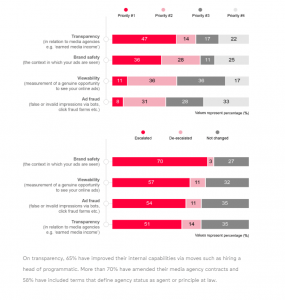
Fall is my favorite season. Everything is constantly changing: the weather, the daylight, the leaves, the routines, and of course, the food.
Restaurants, breweries, markets, bakeries, and coffee shops are just some of the places where you can go to get a taste of fall.
One of the things I love most about enjoying a taste of fall, is that you’re constantly reminded of all of the relationships that go into delivering them to your plate. Farmers, restaurant owners, suppliers, and brewers all rely on each other, and help each other a lot in the process.
As a small business, there’s a good chance you have similar relationships with other business owners to keep things running smoothly.
But did you also know you can build relationships to support your marketing, as well?
Co-marketing is the process of working with your best online partners to help build your audience and generate more customers with relevant content and backlinks.
These partners already have the audience and customers you need. Working with them will build your company’s exposure; we call this your Co-Marketing Audience.
If you’re feeling inspired to try co-marketing for your business, here’s how you can get started
1. Find the right partners
The best co-marketing relationships stem from an overlap in audience interests and needs. Search engines can see this relevancy through keyword/content similarity and social signals.
If you’re a farmer growing pumpkins in Illinois, you most likely won’t want to exchange content with a software developer in India.
Instead, target relevant businesses in your space. Think about who you work with on a day-to-day basis. Are there opportunities to work with these people more than you do already?
It’s important to make sure that anyone you’re considering partnering with has an active website and social presence of their own. That way you know you’ll benefit from them promoting your content.
When your partner gives you a shout-out via social media and links back to your own website from the post, you’ll get in front of a new audience, build authority, and show your expertise.
Follow these instructions to find the right co-marketing partners.
2. Write for your collective audience
Successful co-marketing partnerships don’t only exchange promotional content. They exchange useful knowledge and thought-leadership. There is inherent value to the content because there are key takeaways that the reader can’t get anywhere else.
You must communicate with your co-marketing partners to find out what their audience wants to read about:
- What are their main concerns, problems, hopes, dreams, fears?
- What is the tone of the blog?
- What is the key takeaway of the article?
- What value are you bringing to the table?
Once you have that feedback, think about one person who fits all their criteria (their buyer persona) and write to that person as if you’re sitting across the dinner table from them.
Keep these tips in mind when writing for your partners.
3. Promote each other’s content
All relationships are two-way streets, and co-marketing is no exception. A partnership is an arrangement in which parties agree to collaborate to advance their mutual interests. That means that both partners are better off after the partnership is formed than they were before.
It’s imperative that you and your partners use social media and email to promote each other to your respective audiences. Social signals boost search engine rankings which will give you more qualified traffic to your website.
Coordinate messaging and timing so you are able to achieve maximum reach and visibility. If you’re working with a partner three time-zones away, then make sure that you cover your time zone’s promotions and they cover theirs. If you’re in the same time zone, or even the same local market, brainstorm some creative promotional ideas to get in front of a targeted local audience.
4. Review marketing results together
Like the farmer who plans ahead, planting their crops and nurturing them along the way, you will reap what you sow when it comes to co-marketing. Like most marketing-related tactics, planning is required and analytics reviews provide you with the insights you need to generate more results next time.
After you exchange relevant blog posts with one another and promote them to your audiences using social and email, make sure you follow up with your partner.
Share Google analytics data regarding the pageviews and conversions. Share any newsletter open rates and click-through rates along with numbers of social tweets, retweets, favorites, likes, pins, and +1s to determine which networks are working the best.
This review process will help both of you understand how to do better moving forward.
5. Pay it forward
Co-marketing is like good samaritanism. It should be done out of the kindness of your own heart. You should do it to help your partner and their audience. Any benefits you get as a result are an added bonus.
Don’t think of this as a one-time thing that you’re going to immediately benefit from. You will see some immediate results, but unless you’re partnering with someone with a HUGE audience every week, you should expect your results to improve incrementally, over time.
All relationships take time to develop, and the longest standing ones are often the most fruitful. This holds true with co-marketing. This long-term process will really pay off as long as you keep at it, building new relationships and nurturing them to maturity.
Work hard. Stay hungry. Never be satisfied with your co-marketing results. Trust me, you will get better at this. You will be rewarded handsomely for your efforts.
Do you have experience working with co-marketing partners? Or have any questions before you get started? Let us know in the comments!
Business Articles | Business 2 Community
(483)
Report Post






